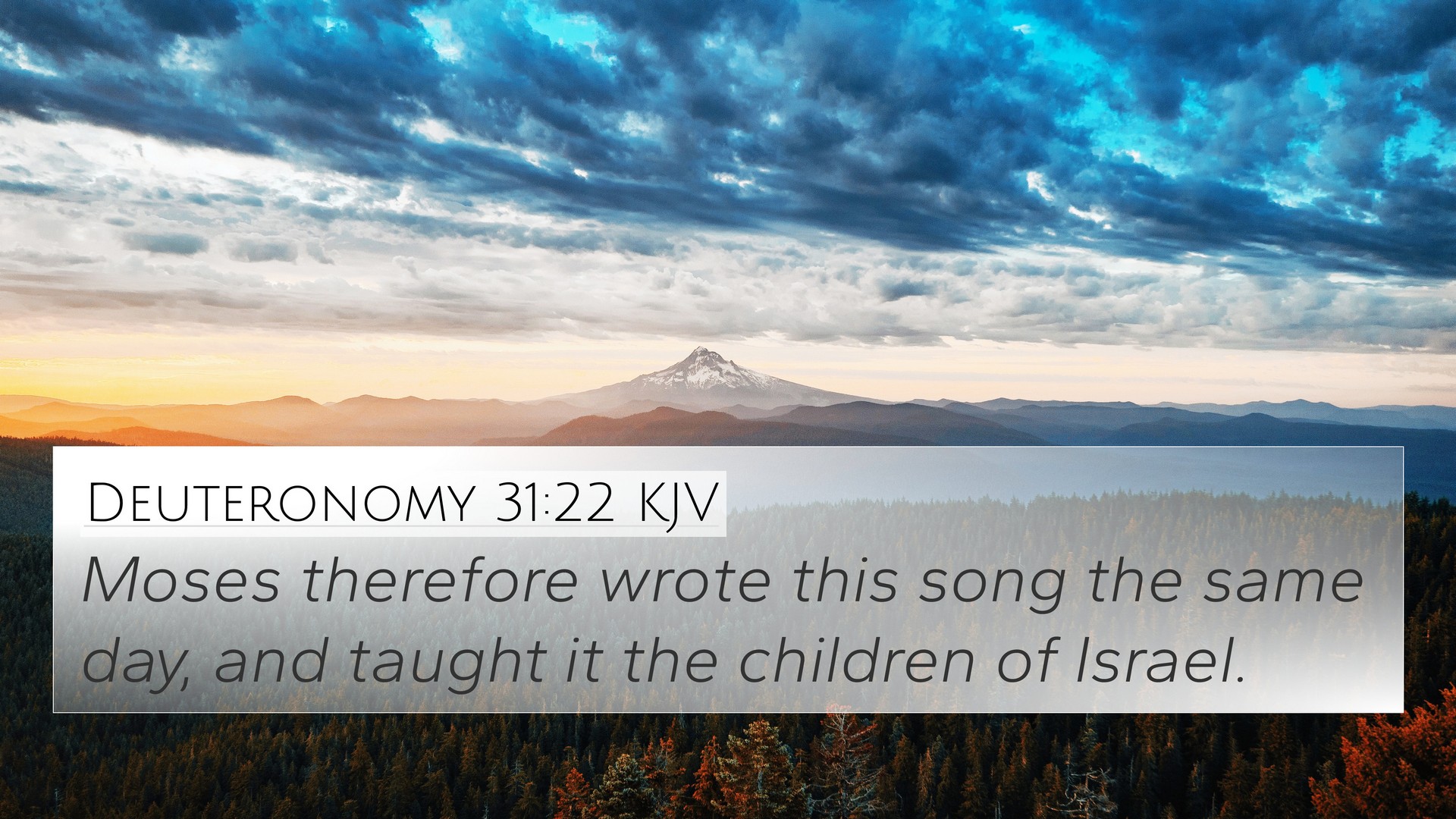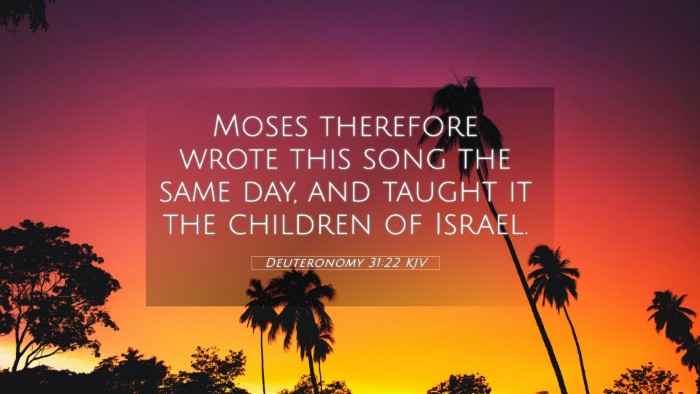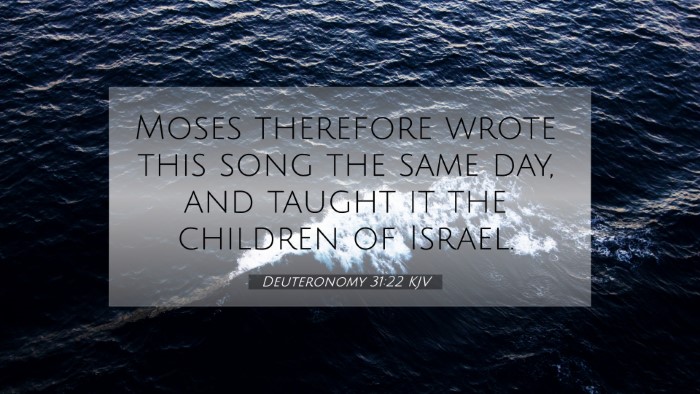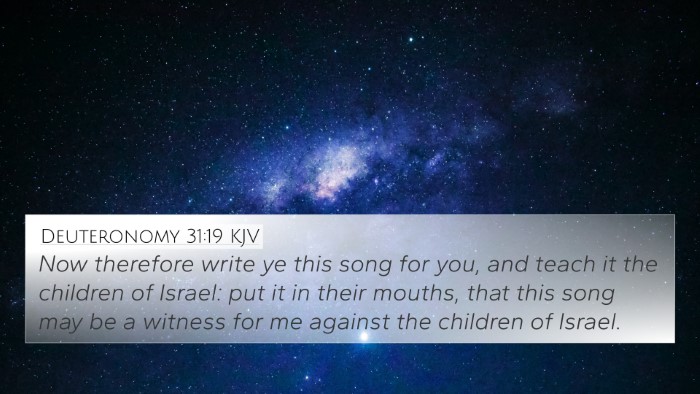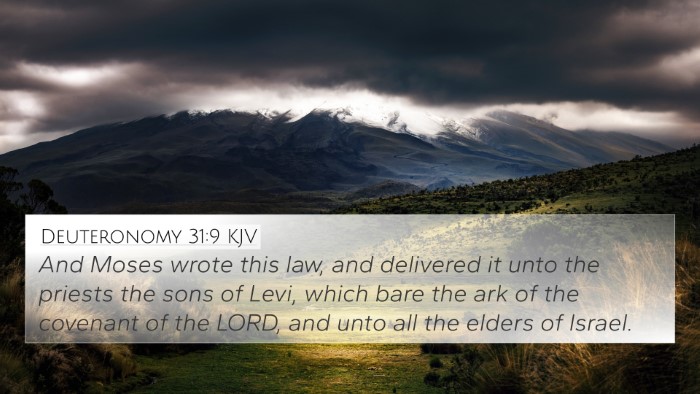Understanding Deuteronomy 31:22
Bible Verse: Deuteronomy 31:22 ("Moses therefore wrote this song the same day, and taught it the children of Israel.")
Context of the Verse
This verse is situated at a critical juncture in the Book of Deuteronomy, where Moses, nearing the end of his leadership, prepares the Israelites for their impending entry into the Promised Land. The "song" referenced indicates a form of poetic worship and instruction meant to serve as a reminder of God's law and faithfulness.
Thematic Bible Verse Connections
- Exodus 15:1 - The Song of Moses after crossing the Red Sea.
- Deuteronomy 31:30 - The song recorded in full, reinforcing the importance of remembering God's words.
- Psalms 78:1-4 - A call to teaching future generations about God’s deeds.
- Revelation 15:3 - The Song of Moses and the Lamb as a symbol of victory.
- 2 Samuel 22:1 - David's song of deliverance encapsulates similar themes of praise and reflection.
- Luke 1:46-55 - The Magnificat, paralleling the themes of praise and God’s faithfulness.
- Romans 15:4 - The importance of the scripture for instruction and hope.
Commentary Insights
Exploring the layers of meaning in Deuteronomy 31:22, we can gather significant insights from various public domain commentaries:
Matthew Henry's Commentary
Matthew Henry emphasizes that this song was intended not only for musical appreciation but serves a profound instructional purpose. Like the songs of old, it encapsulates the history, laws, and the experience of God's people, designed to be sung by future generations as a reminder of their covenant with the Lord.
Albert Barnes' Commentary
Barnes notes that the act of writing a song signifies an important moment in Israel’s narrative. It is a deliberate action reflecting Moses' commitment to God’s ordinances. This act of teaching the lyrics ensures that the generations would carry forth the remembrance of their history and divine statutes.
Adam Clarke's Commentary
According to Clarke, the song serves a dual purpose; it is both a legal statement and a piece of worship. The instructions given highlight the responsibilities of the Israelites to adhere to God's commandments and serve as a perpetual reminder of both blessings and consequences tied to obedience and rebellion.
Cross-Referencing Biblical Texts
Cross-referencing can illuminate the connections and themes woven throughout the scriptures. Deuteronomy 31:22 encourages examining other related scriptures for deeper understanding:
- Exodus 24:7 - The people’s response to God's laws at Sinai.
- Joshua 1:8 - The command to meditate on the Law ensures success and observance of this covenant.
- 1 Chronicles 16:7 - David's direction in worship manifesting through music and remembrance.
- Acts 15:21 - The continuous reading of Moses in synagogues emphasizes the importance of this instruction.
- Hebrews 2:1-3 - The seriousness of neglecting salvation and teachings derived from the old covenant.
Tools for Biblical Cross-Referencing
For effective Bible study and understanding connections between verses, tools like a Bible concordance or a Bible cross-reference guide are invaluable. These resources allow users to identify interconnections and thematic parallels, enriching personal study and enhancing sermon preparation.
How to Use Bible Cross-References
Understanding how to find and utilize cross-references in the Bible can deepen one’s study. Here are some tips:
- Utilize a comprehensive Bible cross-reference system found in most study Bibles.
- Explore thematic connections by exploring related verses contextually.
- Engage in comparative Bible verse analysis to understand contrasts and similarities.
- Utilize online resources and software that provide advanced cross-referencing capabilities.
Concluding Thoughts
Deuteronomy 31:22 encapsulates the importance of memory, instruction, and worship among the Israelites as imparted by Moses. It stands as a lasting testament to the significance of teaching and the enduring legacy of God's commands through song. As we explore cross-referencing opportunities, we uncover layers of meaning and inter-Biblical dialogues that reveal God’s consistent character and the anticipation of His works through history.
By understanding its meaning through public domain commentaries, we can appreciate the rich context and implications of verses like Deuteronomy 31:22 and how they elegantly link the Old Testament with the New, demonstrating the continuity of God’s engagement with His people.
